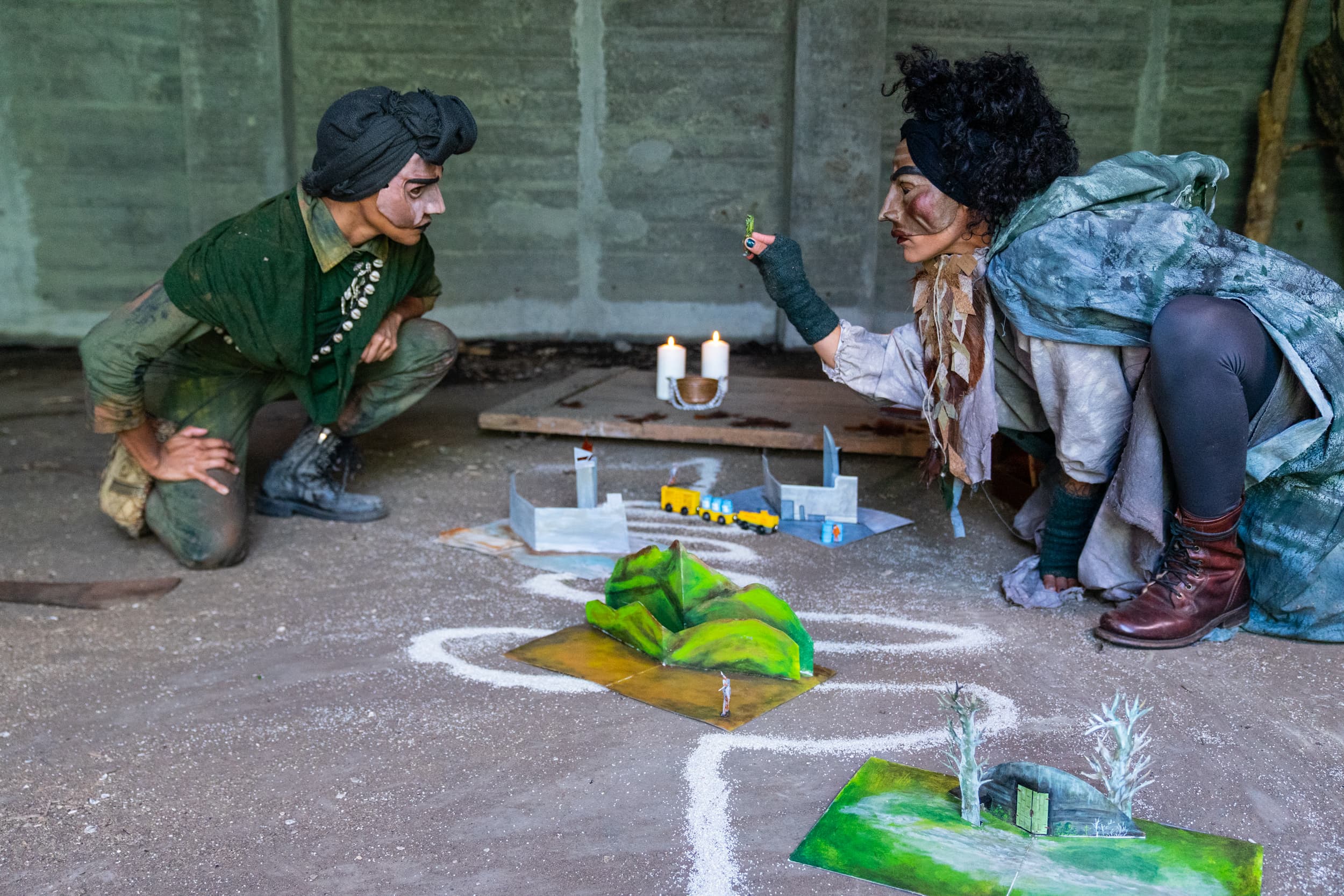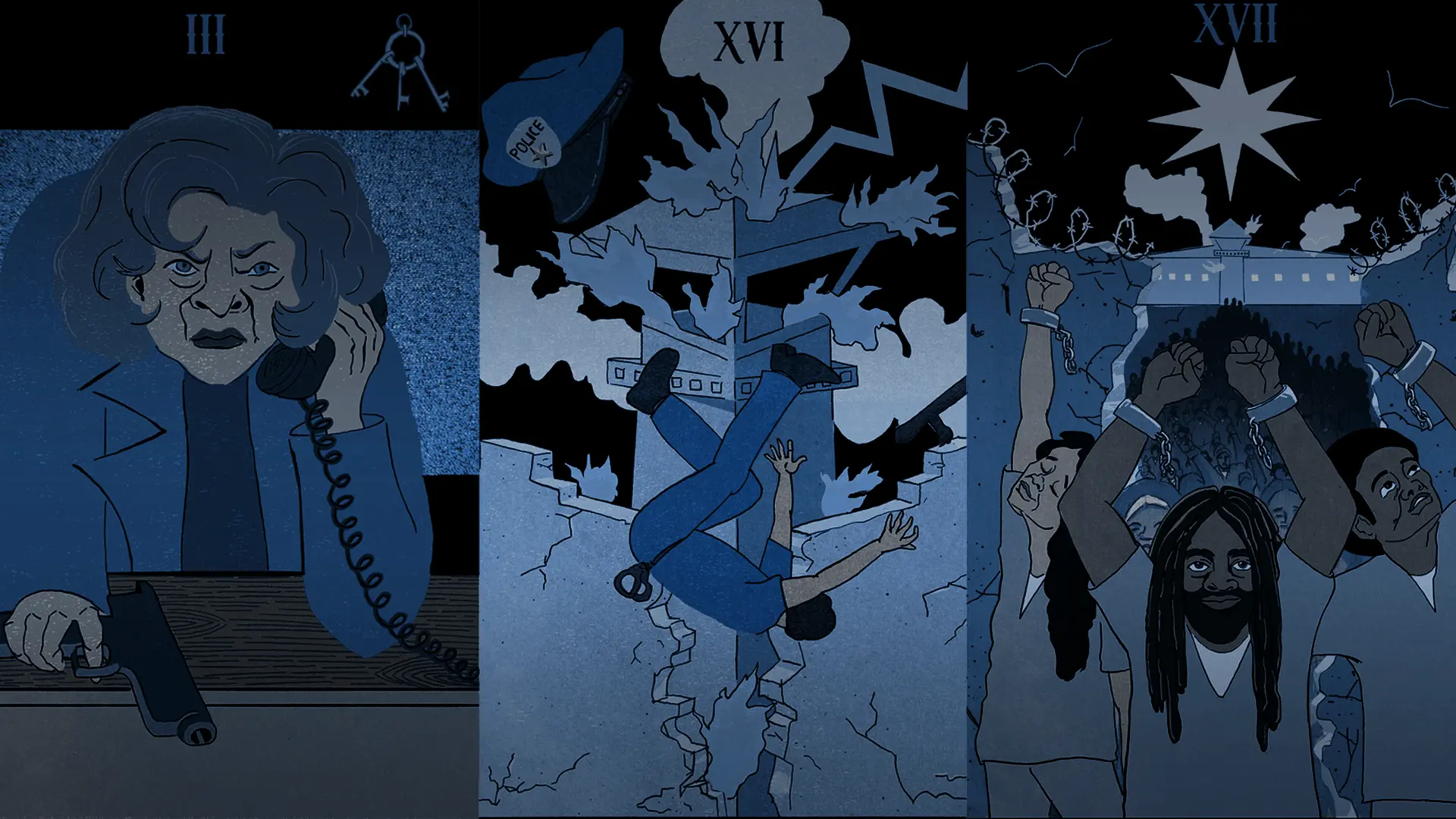
f.a.q.
(Frequently Asked Questions)
- What is On the Eve of Abolition?
On the Eve of Abolition is an original bilingual (Spanish-English), multimedia, and mask/puppet theater performance by Papel Machete about the last day of the last prison in transnational liberated lands of what used to be known as the U.S. and Mexico, after a movement of abolitionists have created the conditions to end the prison industrial complex. The story is set in 2047 and imagines abolition camps, formerly incarcerated people, families, and activists outside, and from within, prisoners organized in this final moment to end all prisons.
We use rod and table puppets, masks, shadow puppet theater, projection, cantastoria (picture storytelling), stop motion animation, and spatial sound to create an immersive experience for the audience. The play is a radical imaginary sci-fi story based on current conditions in the US and Puerto Rico. The project is developed and performed by artists and collaborators of Papel Machete.
For more information about the creation of On the Eve of Abolition, visit our Creative Process page.
- Who is Papel Machete?
Papel Machete is a radical theater and puppetry collective that produces and performs original work throughout Puerto Rico and the US. The collective started on May 1, 2006, during the government shutdown, in response to the economic and political crisis generated by the status of Puerto Rico as a colony of the US. Since then, they have established a body of work inspired by a commonly shared aesthetic and values. Using papier mâché as a main medium, Papel Machete explores a wide range of artforms and styles, including toy theater, cantastorias, shadow theater, table-top puppetry, masks, performing objects, and giant puppets. Papel Machete has brought theater to new audiences and venues to denounce exploitation, build solidarity, and agitate for action in the struggles of frontline communities. They are co-founders and part of the organizing committee of Titeretada, a yearly independent puppetry festival in Puerto Rico.
Papelmachete.com | @papelmachete
- What is Prison Abolition?
We like the definition provided by Critical Resistance. This and more resources about PIC abolition can be found on our What is Prison Abolition? page:
Prison Industrial Complex Abolition is a political vision with the goal of eliminating imprisonment, policing, and surveillance and creating lasting alternatives to punishment and imprisonment. From where we are now, sometimes we can’t really imagine what abolition is going to look like. Abolition isn’t just about getting rid of buildings full of cages. It’s also about undoing the society we live in because the PIC both feeds on and maintains oppression and inequalities through punishment, violence, and controls millions of people. Because the PIC is not an isolated system, abolition is a broad strategy.
An abolitionist vision means that we must build models today that can represent how we want to live in the future. It means developing practical strategies for taking small steps that move us toward making our dreams real and that lead us all to believe that things really could be different. It means living this vision in our daily lives. Abolition is both a practical organizing tool and a long-term goal. -Critical Resistance Definition
- Why create a play about Prison Abolition? Why now?
The U.S. is the largest jailer in the world, incarcerating over two million people in prisons, jails, ICE detentions centers, and juvenile detention centers. This country imprisons and jails millions of Black, transgender, immigrant, indigenous, and poor people annually, significantly damaging the families and communities of those incarcerated. Over the last four decades, the population of individuals incarcerated in women’s prisons has increased by over 700%. Black women are incarcerated at twice the rate of white women and nearly 1 in 2 Black trans women report being incarcerated at least once in their lifetime and are often misgendered and placed in men’s prisons.
Not only has the prison system proven to be a political strategy to keep these populations in cages, it also fails to rehabilitate, stop crime and improve public safety.
Prison abolition is not just about closing jails and prisons al(though this is an important piece). It is about providing the resources we all need to live healthy lives and avoiding punishment-based reactions to so-called crimes. Prison abolition is inherently intersectional, anti-capitalist, anti-racist and provides a vision and roadmap leading to a society that values each life as precious. It is also made up of millions of experiments being created and tested by communities most impacted by the carceral state who are actively building a future without prisons and police.
As artists and cultural organizers, we generate work that supports and expands the political imagination for activists in their community organizing work. The criminal justice system has been an instrument for the displacement of our communities and breaking up of our families, used by the state to consolidate and maintain its economic and political power. Our strategy is to create art that agitates and disrupts current narratives of incarceration, and generate dialogue of an emancipatory future and liberation of all oppressed peoples.
When Papel Machete first imagined On the Eve of Abolition, it was before the George Floyd protests in the U.S. and certainly before the concept of prison abolition was as widely discussed and accepted as it is today. That being said, the U.S. and Puerto Rico have a long way to go before abolition can be realized and for many it is still hard to imagine a world without prisons and police. This is why we believe this project is so important right now to present a vision of what prison abolition and a society beyond capitalism could look like.
[Sources: Mariame Kaba’s PIC Abolition 101, Prison Policy Initiative Whole Pie 2022, Ruth Wilson Gilmore.]
- Why use puppetry and masks to tell this story?
We use diverse forms of storytelling to disrupt current narratives of incarceration and generate a dialogue toward liberation of all oppressed people. Puppetry is limitless in how stories can be told as well as how the audience can relate to what are often considered difficult topics. Although the storytelling techniques used in On the Eve of Abolition are ancient forms connected to folk and popular theater, in this play, Papel Machete and collaborators explore new ways of pushing the boundaries of these forms. We devise using various puppetry styles, masks, and physical theater because it is an effective tool to help audiences re-envision the world.
Puppets become the protagonists in their own story through their inherent expressive and gestural movements and their relationship with the performer’s imagination. Through this exchange, often through metaphor, the object becomes the subject. This opportunity allows for new narratives toward an abolitionist vision of our world. The play invites and engages folks in transformative conversation around prison abolition by presenting alternatives and new concepts within decolonial and liberation struggles in the U.S. and Puerto Rico.
The development of ideas and creation of the story have been devised through a highly collaborative process involving the core crew of artists, starting with speculative fiction writing assignments and puppet experimentation / prototyping. Just as abolitionist organizing is as much about testing and learning from failure as it is about closing prisons, we have collaboratively tested, built, failed, and rebuilt sets, life-size to miniature puppets, full and half masks, and many other performing objects, in-person and virtually throughout the last 3+ years.
6. Is On the Eve of Abolition coming to our town? If not, how can we bring the play to our community?
Thank you so much for your interest in this work. As of now, we plan to tour On the Eve of Abolition to Dallas, New York City, Boston, Vermont, Maine, New Orleans, and San José, CA starting in Fall 2024. Check our Tour page or subscribe to AgitArte’s newsletter for details on tour dates and tickets.
We are interested in building with communities engaged in PIC abolition work and theaters/presenters who can commission this work. Please reach out to discuss possibilities.
7. What other artists, thinkers, scholars, abolitionists and organizers have influenced/inspired this project?
There are many! We’ve listed several in the Resource section of the website.We have been especially inspired by the work of long-time prison abolitionists Ruth Wilson Gilmore and Mariame Kaba, and by the organizing and creative work of our partners Prison Radio and Gallery of the Streets. We integrate Caribbean performance and music with popular theater and storytelling traditions, to create complete worlds for an immersive aesthetic experience. This is consistent with the teachings of puppeteer and long term collaborator, Deborah Hunt.
Visit our Creative Process page to read more about the specific storytelling techniques and traditions we are using in the play.
8. I’ve seen On the Eve of Abolition. Now what?
Thank you for coming to our show! We recognize that cultural work is just one aspect of building toward a future without prisons, policing and surveillance. We want to lift up the critical organizing work of PIC abolition groups in the U.S. like Critical Resistance, Project NIA and Prison Radio. We encourage all who have seen On the Eve of Abolition to follow their work and find ways to get plugged in.
We also recommend visiting our Actions for Abolition page for up-to-date actions you can take today in solidarity with incarcerated people and their families, as well as ongoing abolitionist organizing campaigns. Consider reaching out to an incarcerated person and building a relationship with them. Black & Pink is a great resource if you’re new to being a penpal. Prison Radio has a list of correspondents reporting on conditions inside of prisons and their contact information.
